
Comet Hale–Bopp is a long-period comet that was one of the most widely observed of the 20th century and one of the brightest seen for many decades.

Comet Hyakutake is a comet discovered on 31 January 1996. It was dubbed the Great Comet of 1996; its passage to within 0.1 AU (15 Gm) of the Earth on 25 March was one of the closest cometary approaches of the previous 200 years. Reaching an apparent visual magnitude of zero and spanning nearly 80°, Hyakutake appeared very bright in the night sky and was widely seen around the world. The comet temporarily upstaged the much anticipated Comet Hale–Bopp, which was approaching the inner Solar System at the time.
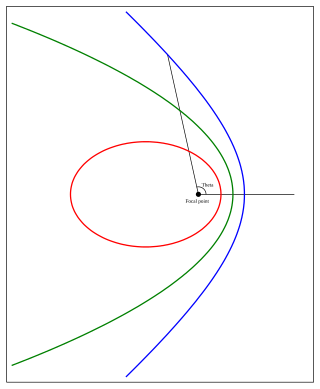
In astrodynamics, the orbital eccentricity of an astronomical object is a dimensionless parameter that determines the amount by which its orbit around another body deviates from a perfect circle. A value of 0 is a circular orbit, values between 0 and 1 form an elliptic orbit, 1 is a parabolic escape orbit, and greater than 1 is a hyperbola. The term derives its name from the parameters of conic sections, as every Kepler orbit is a conic section. It is normally used for the isolated two-body problem, but extensions exist for objects following a rosette orbit through the Galaxy.
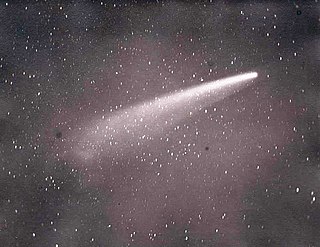
The Great Comet of 1882, formally designated as C/1882 R1, 1882 II, and 1882b, was a comet which became very bright in September 1882. It was a member of the Kreutz Sungrazers, a family of comets which pass within 1 R☉ of the Sun's photosphere at perihelion.

Comet Arend–Roland was discovered on November 6, 1956, by Belgian astronomers Sylvain Arend and Georges Roland on photographic plates. As the eighth comet found in 1956, it was named Arend–Roland 1956h after its discoverers. Because it was the third comet to pass through perihelion during 1957, it was then renamed 1957 III. Finally, it received the standard IAU designation C/1956 R1 (Arend–Roland), with the "C/" indicating that it was a non-periodic comet and the "R1" showing that it was the first comet reported as discovered in the half-month designated by "R". The last is equivalent to the period September 1–15.
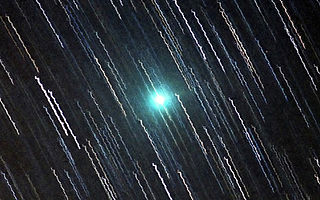
Comet IRAS–Araki–Alcock is a long-period comet that, in 1983, made the closest known approach to Earth of any comet in the last 200 years, at a distance of about 0.0312 AU.
The Comet of 1729, also known as C/1729 P1 or Comet Sarabat, was an assumed parabolic comet with an absolute magnitude of −3, possibly the brightest ever observed for a comet; it is therefore considered to be potentially the largest comet ever seen. With an assumed eccentricity of 1, it is unknown if this comet will return in a hundred thousand years or be ejected from the Solar System.

The Great Comet of 1577 is a non-periodic comet that passed close to Earth with first observation being possible in Peru on 1 November 1577. Final observation was made on 26 January 1578.
4151 Alanhale, provisional designation 1985 HV1, is a carbonaceous Themistian asteroid from the outer region of the asteroid belt, approximately 19 kilometers in diameter. It was discovered by the American astronomer couple Carolyn and Eugene Shoemaker at the U.S. Palomar Observatory, California, on 24 April 1985. It was named for American astronomer Alan Hale.
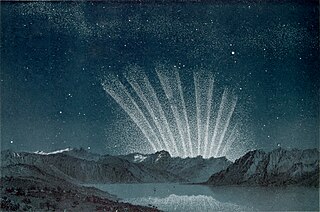
The Great Comet of 1744, whose official designation is C/1743 X1, and which is also known as Comet de Chéseaux or Comet Klinkenberg-Chéseaux, was a spectacular comet that was observed during 1743 and 1744. It was discovered independently in late November 1743 by Jan de Munck, in the second week of December by Dirk Klinkenberg, and, four days later, by Jean-Philippe de Chéseaux. It became visible with the naked eye for several months in 1744 and displayed dramatic and unusual effects in the sky. Its absolute magnitude – or intrinsic brightness – of 0.5 was the sixth highest in recorded history. Its apparent magnitude may have reached as high as −7, leading it to be classified as a Great Comet. This comet is noted especially for developing a 'fan' of six tails after reaching its perihelion.
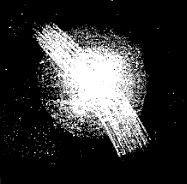
The Great Comet of 1823, also designated C/1823 Y1 or Comet De Bréauté-Pons, was a bright comet visible from December 1823 to April 1824.

Comet Swift–Tuttle is a large periodic comet with a 1995 (osculating) orbital period of 133 years that is in a 1:11 orbital resonance with Jupiter. It fits the classical definition of a Halley-type comet, which has an orbital period between 20 and 200 years. The comet was independently discovered by Lewis Swift on 16 July 1862 and by Horace Parnell Tuttle on 19 July 1862.
2013 AZ60 is a small Solar System body (extended centaur) from the scattered disk or inner Oort cloud. 2013 AZ60 has the 8th-largest semi-major axis of a minor planet not detected outgassing like a comet (2013 BL76, 2005 VX3 and 2012 DR30 have a larger semi-major axis).

C/1807 R1, also known as the Great Comet of 1807, is a long-period comet. It was visible to naked-eye observers in the northern hemisphere from early September 1807 to late December, and is ranked among the great comets due to its exceptional brightness.

323P/SOHO is a periodic comet with an orbital period of 4.15 years discovered in images obtained by the Solar and Heliospheric Observatory (SOHO). It is considered to be a sungrazing comet due to its perihelion being very close to the Sun. 323P/SOHO has the smallest perihelion of all numbered comets.

C/2020 F3 (NEOWISE) or Comet NEOWISE is a long period comet with a near-parabolic orbit discovered on March 27, 2020, by astronomers during the NEOWISE mission of the Wide-field Infrared Survey Explorer (WISE) space telescope. At that time, it was an 18th-magnitude object, located 2 AU away from the Sun and 1.7 AU away from Earth.

C/2014 UN271 (Bernardinelli–Bernstein), simply known as C/2014 UN271 or Comet Bernardinelli–Bernstein (nicknamed BB), is a large Oort cloud comet discovered by astronomers Pedro Bernardinelli and Gary Bernstein in archival images from the Dark Energy Survey. When first imaged in October 2014, the object was 29 AU (4.3 billion km; 2.7 billion mi) from the Sun, almost as far as Neptune's orbit and the greatest distance at which a comet has been discovered. With a nucleus diameter of at least 120 km (75 mi), it is the largest Oort cloud comet known. It is approaching the Sun and will reach its perihelion of 10.9 AU (just outside of Saturn's orbit) in January 2031. It will not be visible to the naked eye because it will not enter the inner Solar System.
C/2024 L5 (ATLAS) is a comet that was discovered on 14 June 2024 as A117uUD by the Asteroid Terrestrial-impact Last Alert System (ATLAS), South Africa, Sutherland. It will reach perihelion on 10 March 2025 at 3.432 AU (513.4 million km) from the Sun.

Comet Tago–Sato–Kosaka, formally designated as C/1969 T1, is a non-periodic comet that became visible in the naked eye between late 1969 and early 1970. It was the first comet ever observed by an artificial satellite.
Comet Donati, formally designated as C/1864 R1, is a parabolic comet discovered in 1864. It was the last of five comets discovered by Italian astronomer, Giovanni Battista Donati. This comet might be the potential parent body of the Gamma Normids meteor shower.

















